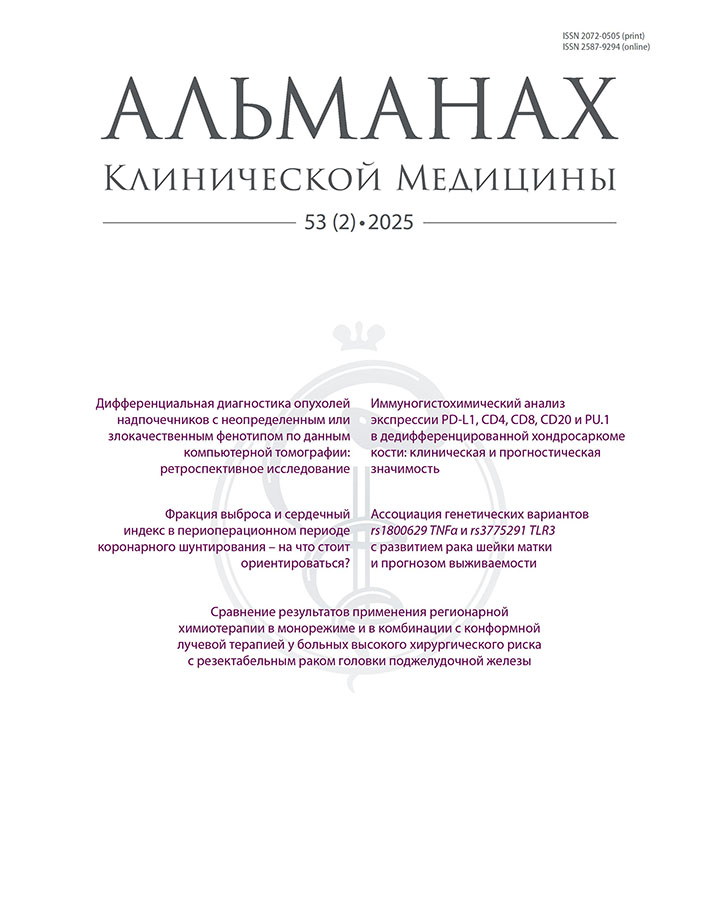Особенности экспрессии коллагена IV типа в базалиоме кожи
- Авторы: Хлебникова А.Н.1, Белова Л.А.1, Гуревич Л.Е.1, Селезнева Е.В.1, Cедова Т.Г.2
-
Учреждения:
- Московский областной научно-исследовательский клинический институт им. М.Ф. Владимирского
- Пермский государственный медицинский университет имени академика Е.А. Вагнера Минздрава России
- Выпуск: Том 48, № 2 (2020)
- Страницы: 102-109
- Раздел: ОРИГИНАЛЬНЫЕ СТАТЬИ
- URL: https://almclinmed.ru/jour/article/view/1256
- DOI: https://doi.org/10.18786/2072-0505-2020-48-013
- ID: 1256
Цитировать
Полный текст
Аннотация
Актуальность. Коллаген IV типа - основной компонент базальной мембраны, обеспечивающий ее целостность. При разрушении базальной мембраны отмечается исчезновение экспрессии коллагена IV типа, что напрямую связано с возрастанием инвазивного потенциала опухоли. В полной мере не определены особенности экспрессии этого белка при различных морфологических типах базалиомы. Цель - изучение взаимосвязи между экспрессией коллагена IV типа, морфологическим строением и инвазивным потенциалом базалиомы. Материал и методы. Проведено иммуногистохимическое исследование с антителами к коллагену IV типа биопсийного материала 30 базалиом кожи. Результаты. Линейная непрерывная экспрессия коллагена IV типа отличала (р < 0,0083) поверхностный мульти-центрический тип от солидного, микронодулярного и инфильтративного. В микронодулярном и инфильтративном типах базалиомы чаще всего экспрессия коллагена IV отсутствовала, однако статистически значимого отличия солидного от каждого из этих типов получено не было. Суммарно агрессивные типы базалиомы (микронодулярный и инфильтративный) значимо (р = 0,033) отличались от солидного тем, что в них преимущественно отсутствовала экспрессия коллагена IV типа. Исключительно линейная непрерывная экспрессия наблюдалась в базалиомах глубиной < 0,825 мм. Заключение. Установлены различия в экспрессии коллагена IV типа в зависимости от морфологического типа базалиомы, преобладание линейной непрерывной экспрессии в поверхностном мультицентрическом типе и ее отсутствие в ми-кронодулярном и инфильтративном.
Ключевые слова
Об авторах
А. Н. Хлебникова
Московский областной научно-исследовательский клинический институт им. М.Ф. Владимирского
Автор, ответственный за переписку.
Email: alb9696@yandex.ru
ORCID iD: 0000-0003-4400-5631
Хлебникова Альбина Николаевна - доктор медицинских наук, профессор, профессор кафедры дерматовенерологии и дерматоонкологии факультета усовершенствования врачей.
129110, Москва, ул. Щепкина, 61/2.
Тел.: +7 (495) 631 01 63.
РоссияЛ. А. Белова
Московский областной научно-исследовательский клинический институт им. М.Ф. Владимирского
Email: bla83@inbox.ru
Белова Любовь Анатольевна -старший лаборант отдела координации и планирования научных исследований.
129110, Москва, ул. Щепкина, 61/2.
РоссияЛ. Е. Гуревич
Московский областной научно-исследовательский клинический институт им. М.Ф. Владимирского
Email: larisgur@mail.ru
ORCID iD: 0000-0002-9731-3649
Гуревич Лариса Евсеевна - доктор биологических наук, профессор, ведущий научный сотрудник морфологического отделения отдела онкологии.
129110, Москва, ул. Щепкина, 61/2.
РоссияЕ. В. Селезнева
Московский областной научно-исследовательский клинический институт им. М.Ф. Владимирского
Email: selezneva-elena@mail.ru
ORCID iD: 0000-0002-6181-9031
Селезнева Елена Владимировна - кандидат медицинских наук, ассистент кафедры дерматовенерологии и дерматоонкологии факультета усовершенствования врачей.
129110, Москва, ул. Щепкина, 61/2.
РоссияТ. Г. Cедова
Пермский государственный медицинский университет имени академика Е.А. Вагнера Минздрава России
Email: sedovca-1978@yandex.ru
ORCID iD: 0000-0002-2660-0536
Седова Татьяна Геннадьевна - кандидат медицинских наук, доцент, доцент кафедры дерматовенерологии.
614990, Пермь, ул. Петропавловская, 26.
РоссияСписок литературы
- Lomas A, Leonardi-Bee J, Bath-Hextall F. A systematic review of worldwide incidence of nonmelanoma skin cancer. Br J Dermatol. 2012;166(5):1069-80. doi: 10.1111/j.1365-2133.2012.10830.x.
- Crowson AN. Basal cell carcinoma: biology, morphology and clinical implications. Mod Pathol. 2006;19 Suppl 2:S127-47. doi: 10.1038/modpathol.3800512.
- Vantuchova Y, Curfk R. Histological types of basal cell carcinoma. Scripta Medica Facultatis Medicae Universitatis Brunensis Masarykianae. 2006;79(5-6):261-70.
- Costache M, Georgescu TA, Oproiu AM, Costache D, Naie A, Sajin M, Nica AE. Emerging concepts and latest advances regarding the etiopathogenesis, morphology and immunophenotype of basal cell carcinoma. Rom J Morphol Embryol. 2018;59(2):427-33.
- Крахмаль НВ, Завьялова МВ, Денисов ЕВ, Вторушин СВ, Перельмутер ВМ. Инвазия опухолевых эпителиальных клеток: механизмы и проявления. Acta Naturae. 2015;7(2):18-31. doi: 10.32607/207582512015-7-2-17-28.
- Rowe RG, Weiss SJ. Breaching the basement membrane: who, when and how? Trends Cell Biol. 2008;18(11):560-74. doi: 10.1016/j.tcb.2008.08.007.
- Mylonas CC, Lazaris AC. Colorectal cancer and basement membranes: clinicopathological correlations. Gastroenterol Res Pract. 2014;2014:580159. doi: 10.1155/2014/580159.
- Koikawa K, Ohuchida K, Ando Y, Kibe S, Nakayama H, Takesue S, Endo S, Abe T, Okumura T, Iwamoto C, Moriyama T, Nakata K, Miyasaka Y, Ohtsuka T, Nagai E, Mizumoto K, Hashizume M, Nakamura M. Basement membrane destruction by pancreatic stellate cells leads to local invasion in pancreatic ductal adenocarcinoma. Cancer Lett. 2018;425:65-77. doi: 10.1016/j.canlet.2018.03.031.
- Agarwal P, Ballabh R. Expression of type IV collagen in different histological grades of oral squamous cell carcinoma: an immunohistochemical study. J Cancer Res Ther. 2013;9(2):272-5. doi: 10.4103/09731482.113382.
- Mackie RM, Clelland DB, Skerrow CJ. Type IV collagen and laminin staining patterns in benign and malignant cutaneous lesions. J Clin Pathol. 1989;42(11):1173-7. doi: 10.1136/jcp.42.11.1173.
- Khoshnoodi J, Pedchenko V, Hudson BG. Mammalian collagen IV. Microsc Res Tech. 2008;71(5):357-70. doi: 10.1002/jemt.20564.
- Santos-Garda A, Abad-Hernandez MM, Fonseca-Sanchez E, Julian-Gonzalez R, Galindo-Villardon P, Cruz-Hernandez JJ, Bullon-Sopelana A. E-cadherin, laminin and collagen IV expression in the evolution from dysplasia to oral squamous cell carcinoma. Med Oral Patol Oral Cir Bucal. 2006;11(2):E100-5.
- Arduino PG, Carrozzo M, Pagano M, Broccoletti R, Scully C, Gandolfo S. Immunohistochemical expression of basement membrane proteins of verrucous carcinoma of the oral mucosa. Clin Oral Investig. 2010;14(3):297-302. doi: 10.1007/s00784-009-0296-y.
- Чупров ИН. Клинико-морфологическая характеристика разных типов роста базальноклеточного рака кожи. Вестник Санкт-Петербургского университета. 2009;11(1):145-50.
- Marzuka AG, Book SE. Basal cell carcinoma: pathogenesis, epidemiology, clinical features, diagnosis, histopathology, and management. Yale J Biol Med. 2015;88(2):167-79.
- Welsch MJ, Troiani BM, Hale L, DelTondo J, Helm KF, Clarke LE. Basal cell carcinoma characteristics as predictors of depth of invasion. J Am Acad Dermatol. 2012;67(1):47-53. doi: 10.1016/j.jaad.2011.02.035.
- Kallioinen M, Autio-Harmainen H, Dammert K, Risteli J, Risteli L. Discontinuity of the basement membrane in fibrosing basocellular carcinomas and basosquamous carcinomas of the skin: an immunohistochemical study with human laminin and type IV collagen antibodies. J Invest Dermatol. 1984;82(3):248-51. doi: 10.1111/1523-1747.ep12260190.
- Marasa L, Marasa S, Sciancalepore G. Collagen IV, laminin, fibronectin, vitronectin. Comparative study in basal cell carcinoma. Correlation between basement membrane molecules expression and invasive potential. G Ital Dermatol Venereol. 2008;143(3):169-73.
- Quatresooz P, Martalo O, Pierard GE. Differential expression of alpha1 (IV) and alpha5 (IV) collagen chains in basal-cell carcinoma. J Cutan Pathol. 2003;30(9):548-52. doi: 10.1034/j.1600-0560.2003.00118.x.
- Pyne JH, Myint E, Barr EM, Clark SP, Hou R. Basal cell carcinoma: variation in invasion depth by subtype, sex, and anatomic site in 4,565 cases. Dermatol Pract Concept. 2018;8(4):314-9. doi: 10.5826/dpc.0804a13.
Дополнительные файлы








